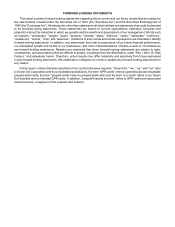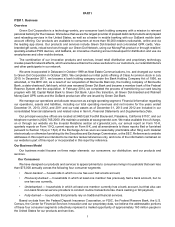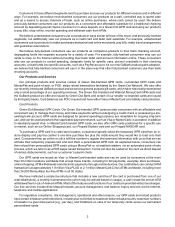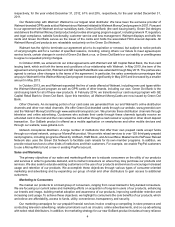Green Dot 2013 Annual Report Download - page 17
Download and view the complete annual report
Please find page 17 of the 2013 Green Dot annual report below. You can navigate through the pages in the report by either clicking on the pages listed below, or by using the keyword search tool below to find specific information within the annual report.10
Activities. Federal laws restrict the types of activities in which bank holding companies may engage, and subject
them to a range of supervisory requirements, including regulatory enforcement actions for violations of laws and policies.
Bank holding companies may engage in the business of banking and managing and controlling banks, as well as
closely related activities. In addition, financial holding companies may engage in a wider set of activities, including with
respect to securities activities and investments in companies engaged in nonbanking activities. The business activities
that we currently conduct are permissible activities for bank holding companies under U.S. law, and we do not expect
the limitations described above will adversely affect our current operations or materially restrict us from engaging in
activities that are currently contemplated by our business strategies. It is possible, however, that these restrictions
could limit our ability to enter other businesses in which we may wish to engage at some time in the future. It is also
possible that in the future these laws may be amended in ways, or new laws or regulations may be adopted, that
adversely affect our ability to engage in our current or additional businesses.
Even if our activities are permissible for a bank holding company, as discussed under “— Capital Adequacy” below,
the Federal Reserve Board has the authority to order a bank holding company or its subsidiaries to terminate any
activity or to require divestiture of ownership or control of a subsidiary in the event that it has reasonable cause to
believe that the activity or continued ownership or control poses a serious risk to the financial safety, soundness or
stability of the bank holding company or any of its bank subsidiaries.
Dividend Restrictions. Bank holding companies are subject to various restrictions that may affect their ability to
pay dividends. Federal and state banking regulations applicable to bank holding companies and banks generally require
that dividends be paid from earnings and, as described under “— Capital Adequacy” below, require minimum levels
of capital, which limits the funds available for payment of dividends. Other restrictions include the Federal Reserve
Board’s general policy that bank holding companies should pay cash dividends on common stock only out of net income
available to stockholders for the preceding year or four quarters and only if the prospective rate of earnings retention
is consistent with the organization’s expected future needs and financial condition, including the needs of each of its
bank subsidiaries. In the current financial and economic environment, the Federal Reserve Board has indicated that
bank holding companies should carefully review their dividend policies and has discouraged dividend pay-out ratios
that are at the 100% level unless both their asset quality and capital are very strong. A bank holding company also
should not maintain a dividend level that places undue pressure on the capital of its bank subsidiaries, or that may
undermine the bank holding company’s ability to serve as a source of strength for its bank subsidiaries. See “— Source
of Strength” below.
As part of our financial commitments to the Federal Reserve Board and Utah Department of Financial Institutions,
our subsidiary bank, Green Dot Bank, is restricted from paying dividends for 3 years from the date of acquisition.
Capital Adequacy. Bank holding companies and banks are subject to various requirements relating to capital
adequacy, including limitations on leverage. As a bank holding company that is a financial holding company, we are
required to be “well-capitalized,” meaning we must maintain a ratio of Tier 1 capital to risk-weighted assets of at least
6% and a ratio of total capital to risk-weighted assets of at least 10%. In addition, we are also subject to the generally
applicable bank holding company minimum Tier 1 leverage ratio of 4%, which is the ratio of Tier 1 capital to average
total consolidated assets. Tier 1 capital, or “core” capital, generally consists of common stockholders’ equity, perpetual
non-cumulative preferred stock and, up to certain limits, other capital elements. Tier 2 capital consists of supplemental
capital items such as the allowance for loan and lease losses, certain types of preferred stock, hybrid capital securities
and certain types of debt, all subject to certain limits. Total capital is the sum of Tier 1 capital plus Tier 2 capital.
Our subsidiary bank is also subject to separate capital and leverage requirements that we have committed to with
the Federal Reserve Board and Utah Department of Financial Institutions. As of December 31, 2013, we and our
subsidiary bank are each “well-capitalized” under the above standards and presently exceed our respective capital
and leverage commitments.
In December 2010, the international Basel Committee on Banking Supervision reached an agreement on new risk-
based capital, leverage and liquidity standards, known as “Basel III.” In June 2012, the Federal Reserve and other
U.S. banking regulators proposed rules to implement many aspects of Basel III in the United States. The U.S. Basel
III proposals contain new capital standards that would raise the quality of capital, increase minimum capital ratios and
strengthen counterparty credit risk capital requirements. The U.S. Basel III proposals also include a new definition of
common equity Tier 1 capital and would require that certain levels of such common equity Tier 1 capital be maintained.
The proposals also include a new capital conservation buffer, which would impose a common equity requirement above
the new minimum that can be depleted under stress, and could result in restrictions on capital distributions and
discretionary bonuses under certain circumstances, as well as a new standardized approach for calculating risk-
weighted assets.
























